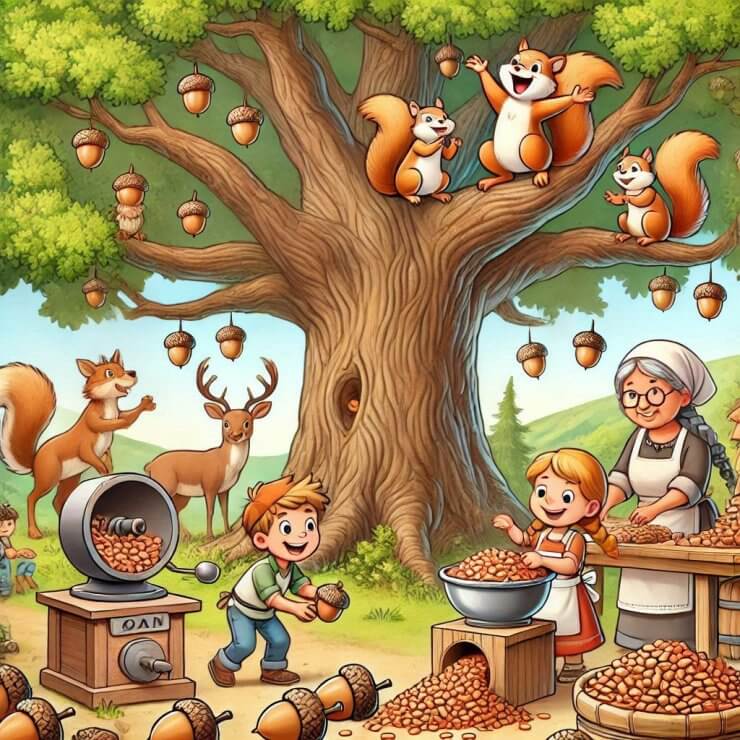Read by Michael Flamel

The Good-Natured Tale of Oaks and Acorns
There’s something undeniably majestic about oak trees. With their branches outstretched in triumph, they stand like guardians of the forest, quietly watching as centuries pass and countless squirrels plot their next heist. These squirrels, by the way, are the original acorn investors, stashing more than they can eat—many of which sprout into new trees, creating nature’s most adorable “stockpile” system.
But here’s the twist: squirrels aren’t the only creatures who appreciate the bounty of acorns. Long before supermarkets stocked shelves with almond and oat milk, Native American communities were busy unlocking the culinary potential of acorns. For them, oak trees were more than majestic landmarks—they were an essential part of life, offering a rich, nutritious food source through their acorns.
Acorns in Native American Cuisine
Acorns were a staple food for many Native American tribes, including the Miwok, Chumash, and Lenape peoples. The tribes developed ingenious methods for processing acorns, transforming the bitter nuts into nourishing flour. But first, they had to remove the tannins—the compounds responsible for the acorn’s natural bitterness. Through careful leaching (often involving soaking the acorns in streams or repeatedly rinsing them), these ancient food pioneers turned acorns into a versatile base ingredient.
Once processed, acorn flour could be used in porridge, bread, or even thickened stews. Acorn mush—imagine oatmeal but earthier—was a comforting dish on cold nights. By blending it with dried berries, nuts, or honey, the tribes created meals that sustained them through Winter’s toughest challenges.
How to Harvest and Use Acorns in Your Kitchen
Today, you don’t need a forest stream to prepare acorns for cooking (though it might enhance the ambience). Here’s how you can bring a bit of oak tree magic into your own kitchen:
Collect the Acorns: Fall is prime time for acorn collection. Look for brown, mature acorns. (Green ones aren’t ready.) Avoid any with tiny holes—those likely house insect friends.
Shelling the Acorns: Crack open the hard shell with a nutcracker or hammer. Inside, you’ll find the meat of the acorn, which looks like a small nut.
Leaching the Tannins: Place the shelled acorns in a bowl of cold water and rinse repeatedly until the water runs clear. Or, for the adventurous, boil them in several changes of water. This removes the bitterness.
Drying and Grinding: Once leached, dry the acorns in the oven at a low temperature. Then grind them into a flour-like consistency using a food processor or mortar and pestle.
Cooking with Acorn Flour: Use your acorn flour to make pancakes, bread, or even cookies. Its nutty flavor pairs wonderfully with cinnamon, honey, and dark chocolate.
Fun Facts About Oak Trees and Acorns
Oak Trees Play the Long Game: Some oak trees don’t produce their first acorns until they’re 50 years old, but once they get going, they can produce tens of thousands of acorns a year. Talk about a slow starter!
The Squirrelly Side of Oaks: Squirrels forget about 74 percent of the acorns they bury—accidentally becoming some of nature’s most effective tree planters. Now that’s a productive oversight!
Oak Varieties Galore: There are more than 600 species of oak trees across the world. From the mighty Red Oak to the elegant White Oak, each has its own acorn style—some sweeter than others.
Acorn Coffee, Anyone? During tough times, people have brewed acorns into a caffeine-free coffee substitute. If you want to impress at your next brunch, offer your guests a cup of oak-spresso.
A Tree of Immense Longevity: Some oak trees live for over 1,000 years. Imagine the stories they’d tell if they could talk—probably starting with, “Once upon a squirrel…”
Closing Thought
The oak tree, with its towering branches and humble acorns, reminds us that even the smallest offerings can make a big difference. Whether feeding wildlife or inspiring new kitchen adventures, the oak’s legacy is one of resilience, nourishment, and quiet generosity. So, the next time you stroll under an oak tree, give it a nod of appreciation—and perhaps pocket a few acorns for your next culinary experiment!


 Previous
Previous

